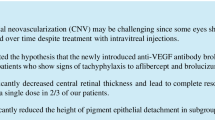Abstract
Purpose
To evaluate by MFERG and OCT the macular function before and after intravitreal use of bevacizumab (Avastin) in eyes suffering from CNV due to ARMD.
Methods
Eighteen eyes with subfoveal CNV due to ARMD were studied before and after intravitreal use of bevacizumab with MFERG and OCT. The post treatment follow up was three months.
Results
Before treatment, OCT shows an increase of the retinal thickening of the fovea and the electrical response densities in the fovea and parafovea were decreased in all patients. Three months after treatment, OCT showed a real resolution of the subretinal fluid. The electrical responses in the fovea and parafovea remained the same or slightly improved in some cases. The intraocular pressure remained normal and no inflammation was observed.
Conclusion
The intravitreal use of bevacizumab may provide anatomical correlates that support the concept of disease amelioration but the functional improvement of the macula three months after treatment is not obvious. However the method is promising and needs further evaluation.



Similar content being viewed by others
References
Kroll P, Meyer CH (2006) Which treatment is best for which AMD patients. Br J Ophthalmol 90:128–130
Chang TS, Freund KB, de la Cruz Z, Yannuzi LA, Green WR (1994) Clinicopathological correlation of choroidal neovascularisation demonstrated by indocyanine green angiography in a patient with retention of good vision for almost four years. Retina 14:114–124
Green WR, Wilson DJ (1986) Choroidal neovascularisation. Ophthalmology 93:1169–1176
Green WR, Enger C (1993) Age related macular degeneration histopathologic studies. The 1992 Lorenz E. Zimmerman Lecture. Ophthalmology 100:1519–1535
Macular Photocoagulation Study Group. (1991) Subfoveal neovascular lesions in age related macular degeneration. Guidelines for evaluation and treatment in the macular photocoagulation study. Arch Ophthalmol 109:1242–1257
Verteporfin in photodynamic therapy Study Group (2001) Vertyeporfin therapy of subfoveal choroidal neovascularisation in age related macular degeneration: two years results of randomized clinical trials including lesions with occult or classic choroidal neovasularisation-verteporfin in photodynamic therapy report 2. Am J Ophthalmol 131:541–560
TAP Study Group (2001) Photodynamic therapy of subfoveal choroidal neovascularisation in age related macular degeneration with Verteporfin: two years results of 2 randomized clinical trials-TAP Report 2. Arch Ophthalmol 119:198–207
Gragoudas ES, Adamis AP, Cunningham ET et al (2004) Pegaptanid for neovasular age related macular degeneration. N Engl J Med 351:2805–2816
Spaide R (2006) New treatments for AMD. Ophthalmology 113:160–161
Ferrara N, Hillan KJ, Gerber HP, Novotny W (2004) Discovery and development of bevacizumab, an anti-VEGF antibody for treating cancer. Nat Rev Drug Discov 3:391–400
Sutter EE, Tran D (1992) The field topography of ERG in man, 1. The photopic luminance response. Vision Res 32:433–466
Michels S, Rosenfeld PJ, Puliafito CA et al (2005) Systemic bevacizumab (Avastin) therapy for neo-vascular age related macular degeneration: twelve-week results of an uncontrolled open-label study. Ophthalmology 112:1035–1074
Rosenfeld PJ, Moshfeghi AA, Puliafito CA et al (2005) Optical coherence tomography findings after an intravitreal injection of bevacizumab (Avastin) for neovascular age related macular degeneration. Ophthalmic Surg Lasers Imaging 36:270–271
Spaide FR, Laud K, Fine HF et al (2006) Intravitreal bevacizumab treatment of choroidal neovascularization secondary to age related macular degeneration. Retina 26:383–390
Feigl B, Brown B, Lovie-Kitchin J, Lee L (2005) Dynamics of retinal function after multiple photodynamic therapies in age related macular degeneration. Doc Ophthalmologica 111:135–148
Moschos M, Panayotidis D, Theodossiadis G, Moschos MM (2004) Assessment of macular function by electroretinography in age-related macular degeneration before and after photodynamic therapy. J Fr Ophtalmologie 27:1001–1006
Author information
Authors and Affiliations
Corresponding author
Rights and permissions
About this article
Cite this article
Moschos, M.M., Brouzas, D., Apostolopoulos, M. et al. Intravitreal use of bevacizumab (Avastin) for choroidal neovascularization due to ARMD: a preliminary multifocal-ERG and OCT study. Doc Ophthalmol 114, 37–44 (2007). https://doi.org/10.1007/s10633-006-9036-7
Received:
Published:
Issue Date:
DOI: https://doi.org/10.1007/s10633-006-9036-7




